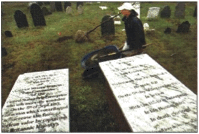First Workday Article
City’s historic burial ground getting new life
Trees are being planted in the Eastern Cemetery, and visitors soon will be welcome

Staff photo by Doug Jones.
Turner Kruysman wheels a load of fertilized loam through the rain on Friday past two of the most famous markers in Eastern Cemetery, those of the captains of the USS Enterprise and the HMS Boxer.
By Ann S. Kim, Staff Writer
When Kathleen Carr-Bailey found out about a tree-planting project in Eastern Cemetery, she jumped at the opportunity to get into the burial ground at the foot of Portland’s Munjoy Hill.
Baily has long been intrigued by the cemetery—Portland’s oldest burial ground and the resting place of a commodore, commoners, the city’s earliest settlers and its first bank robber. She also regretted that the cemetery, established in 1668, had fallen into disrepair.
It should be a peaceful place, a place of beauty,” said Bailey, whose participation counted toward requirements for her master gardener class. “This is a project that is near and dear to my heart.”
So despite drenching rain, Bailey showed up at the cemetery Friday afternoon to plant trees. She wasn’t alone in her fondness for the cemetery; 14 people participated in the planting event.
The trees—hawthorne, beech, ash and tulip, to name a few—are part of a master landscaping plan developed by Barry Hosmer, a landscape architect based in Portland.
Seeing the barren, nearly treeless cemetery, Hosmer often had wondered how it got into that condition. He started researching the cemetery in 1992 and in 1995 presented a design that was approved by Portland’s historic preservation panel.
It wasn’t possible to figure out exactly what used to grow in Eastern Cemetery, but historical documents, old postcards and aerial photos provided snippets.
Hosmer’s plan calls for recreating an “allee” on “Funeral Lane,” a gravel, L-shaped path once lined with American elms, sugar maples and disease resistant hybrid elms. There are also less formal plantings using trees that could have been in use in the past 100 years.
About 30 trees were planted Friday, bringing the total to nearly 100. Those trees represent more than half of those called for in Hosmer’s plan.
Christina White, organizer of Friday’s planting, said the turnout is an example of how people are ready to reclaim the cemetery, which is on the National Register of Historic Places.
“I think there is a pent-up demand in terms of people wanting to know what that place is, what it holds,” said White, who leads tours at the site for Greater Portland Landmarks. “I hear it all the time.”
Soon, more people will be able to explore the cemetery. White said the city will be leaving the gate unlocked during daylight hours, a move she believes will help improve the cemetery’s condition.
Leana Good-Simpson, an office manager for a brokerage firm, was excited to get into the cemetery for the tree-planting. “I’m looking forward to helping them really clean it up so people will go visit it and respect it and keep it clean,” said Good Simpson, who is interested in headstones and genealogy.
Turner Kruysman, a federal government researcher, said it was the history that drew him to the cemetery, especially the side by-side graves of two famous War of 1812 casualties: Samuel Blyth, the captain of the British ship the HMS Boxer; and William Burrows, the captain of the American ship the USS Enterprise. He plans to return to examine them and see the planting team’s handiwork.
“It was just wonderful,” he said “It’s going to be fun to look at the trees in later years as they grow.”
Bailey said the experience gave her goosebumps—and not just because of the rain.
“If they asked me to go back tomorrow, I’d go,” she said “But I’d have to get new boots, because mine are soaked.”
Graves of Note
The graves in Eastern Cemetery include that of Commodore Edward Preble, who served in the Revolutionary War and was the first commander of a U.S. warship to carry the colors around the Cape of Good Hope. He commanded the assault on Tripoli in 1804, and for that was presented a gold medal by Congress. The graves of two War of 1812 captains also are there. Samuel Blyth, the captain of the British ship the HMS Boxer; and William Burrows, the captain of the American ship the USS Enterprise, died in battle Sept. 5, 1813.
Compiled by researcher Susan Butler.
This article was retrieved from Local & State (Section B) of the Portland Press Herald, Final Edition that was published Saturday, May 13, 2006.